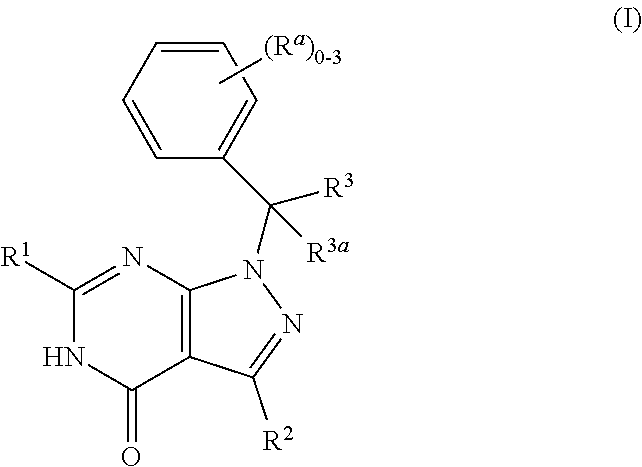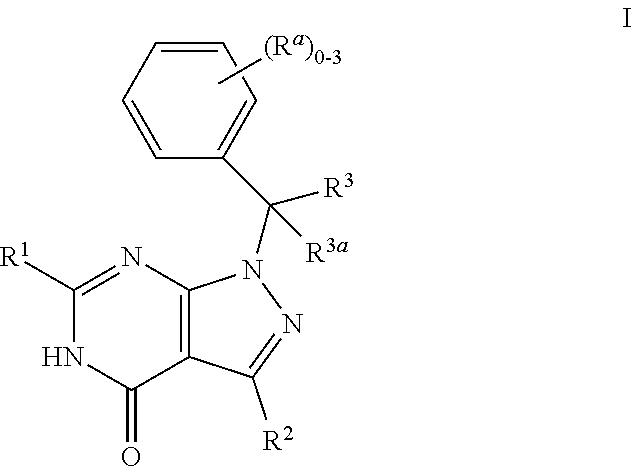Dihydropyrazolopyrimidinone compounds as PDE2 inhibitors
a technology of dihydropyrazolopyrimidinone and dihydropyrazolopyrimidinone, which is applied in the direction of drug composition, nervous disorder, organic chemistry, etc., can solve the problems of high non-compliance or discontinuation rate of medication, lack of efficacy, and high rate of non-compliance or discontinuation of medication
- Summary
- Abstract
- Description
- Claims
- Application Information
AI Technical Summary
Benefits of technology
Problems solved by technology
Method used
Image
Examples
preparatory example 1
[0221]
2-Methyl-1-(4-(2,2,2-trifluoroethyl)phenyl)propan-1-one (Scheme 1)
Step 1. 4-Methylbenzoyl chloride
[0222]To a solution of 4-methylbenzoic acid (10.0 g, 73.4 mmol) in DCM (100 mL) was added oxalyl chloride (12.5 mL, 147.0 mmol) dropwise at 0° C. The resulted solution was warmed to room temperature and stirred for 16 h. The resulting solution was concentrated under vacuum. The title compound was obtained as a liquid and used for next step directly without further purification.
Step 2. N-Methoxy-N,4-dimethylbenzamide
[0223]To a solution of 4-methylbenzoyl chloride (10.0 g, 64.7 mmol) and N,O-dimethylhydroxyl-amine hydrochloride (8.20 g, 84.0 mmol) in DCM (100 ml) was added triethylamine (27 mL, 194.0 mmol) dropwise at 0° C. The resulting mixture was warmed to room temperature and stirred for 2 h. The reaction mixture was quenched with water (50 mL) and extracted with ethyl acetate (3×50 mL). The combined organic layers were washed with brine (100 mL), dried over anhydrous sodium sul...
preparatory example 4
[0227]
Cyclopropyl(3-fluoro-4-(2,2,2-trifluoroethyl)phenyl)methanone (Scheme 2)
Step 1. Methyl 4-(bromomethyl)-3-fluorobenzoate
[0228]The title compound was prepared using procedures similar to those described in step 3 of Preparatory Example 1 using methyl 3-fluoro-4-methylbenzoate to afford the title compound as an oil. 1H NMR (300 MHz, CDCl3) δ: 7.89-7.70 (m, 3H), 4.75 (s, 2H), 3.88 (s, 3H).
Step 2. Methyl 3-fluoro-4-(2,2,2-trifluoroethyl)benzoate
[0229]The title compound was prepared using procedures similar to those described in step 4 of Preparatory Example 1 using methyl 4-(bromomethyl)-3-fluorobenzoate to afford the title compound as a liquid. MS=236.0 (+EI)
Step 3. 3-Fluoro-4-(2,2,2-trifluoroethyl)benzoic acid
[0230]To a mixture of methyl 3-fluoro-4-(2,2,2-trifluoroethyl)benzoate (3.00 g, 12.7 mmol) in EtOH and water (1:1, 5 mL) at RT was added LiOH (1.52 g, 63.5 mmol). The reaction mixture was stirred for 1 h at 60° C. The resulting mixture was cooled to room temperature and dilu...
preparatory example 7
[0233]
1-(4-(Difluoromethyl)-3-fluorophenyl)propan-1-one (Scheme 3)
Step 1. Methyl 4-(difluoromethyl)-3-fluorobenzoate
[0234]A mixture of 4-bromo-1-(difluoromethyl)-2-fluorobenzene (2.0 g, 8.9 mmol), Pd(OAc)2 (0.40 g, 1.8 mmol), TEA (7.43 mL, 53.3 mmol) and dppf (0.99 g, 1.8 mmol) in DMF (60 mL) and MeOH (20 mL) was stirred at 110° C. under carbon monoxide (5 atm) for 16 h. After cooling to room temperature, the resulting mixture was filtered and the filtrate was concentrated under vacuum. The residue was purified by silica gel column chromatography (0-30% ethyl acetate in petroleum ether) to afford the title compound as an oil. MS=203.9 (+EI).
Step 2. 4-(Difluoromethyl)-3-fluorobenzoic acid
[0235]The title compound was prepared using procedures similar to those described in step 3 of Preparatory Example 4 using methyl 4-(difluoromethyl)-3-fluorobenzoate to afford the title compound as an oil. 1H NMR (300 MHz, CDCl3) δ: 13.30 (br s, 1H), 7.90 (d, J=8.1 Hz, 1H), 7.83-7.76 (m, 2H), 7.30 (t...
PUM
| Property | Measurement | Unit |
|---|---|---|
| flow rate | aaaaa | aaaaa |
| flow rate | aaaaa | aaaaa |
| temperature | aaaaa | aaaaa |
Abstract
Description
Claims
Application Information
 Login to View More
Login to View More - R&D
- Intellectual Property
- Life Sciences
- Materials
- Tech Scout
- Unparalleled Data Quality
- Higher Quality Content
- 60% Fewer Hallucinations
Browse by: Latest US Patents, China's latest patents, Technical Efficacy Thesaurus, Application Domain, Technology Topic, Popular Technical Reports.
© 2025 PatSnap. All rights reserved.Legal|Privacy policy|Modern Slavery Act Transparency Statement|Sitemap|About US| Contact US: help@patsnap.com



